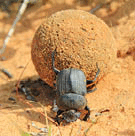
![]()
 One of the most complex design features seen in living things is their built-in navigation systems. How sea turtles can find the same tiny, isolated island beach to lay their eggs year after year is incredibly complex. The ability of a variety of migratory birds to go from wintering grounds to summering grounds and back is astounding. Even more amazing is that there are very simple forms of life that demonstrate an incredible navigating technique.
One of the most complex design features seen in living things is their built-in navigation systems. How sea turtles can find the same tiny, isolated island beach to lay their eggs year after year is incredibly complex. The ability of a variety of migratory birds to go from wintering grounds to summering grounds and back is astounding. Even more amazing is that there are very simple forms of life that demonstrate an incredible navigating technique.
Researchers at Sweden’s Lund University and South Africa’s University of the Witwatersrand reported in Scientific American on studies of the navigation system of dung beetles. Dung beetles take the excrement of elephants and other large animals and roll it into dung balls. Then they roll the balls to their dwelling places to feed themselves and their offspring.
What researchers noticed was that the paths of the dung balls was always a straight line. The beetles use their back legs to roll the balls, so they are not looking where they are going. Try rolling a large ball along uneven ground in a straight line when you are blindfolded. It is virtually impossible to do. The explanation always given was that the beetle was using light from the sun and moon to keep it on target to follow the straight line to its nest. Researchers noticed, however, that on a moonless night that the beetles still rolled their balls in a straight line. When the scientists blindfolded the beetles, they wandered every direction with their balls. It was obvious that sight was involved.
The researchers then transported the beetles to the Johannesburg Planetarium and gave the beetles exposure to the night sky without the moon. The only time the beetles went in a perfectly straight line was when the entire Milky Way was shown to them. Picking the 18 brightest stars in the sky did not help the beetles navigate, but the presence of the Milky Way did. The researchers are saying that this is the first convincing demonstration that there are animals that use the Milky Way for orientation. Proverbs 6:6 advises us to, “Go to the ant, you sluggard; consider its ways and be wise.” It goes on to encourage the reader to be active and do something with the life God has given. We would suggest that the dung beetle has a message for us as well — to look at the world around us and see God’s hand in the design of even the simplest of his creatures. Source: Scientific American, April 2013, page 24.
Picture credits:
© Naturally Africa. Image from BigStockPhoto.com.
